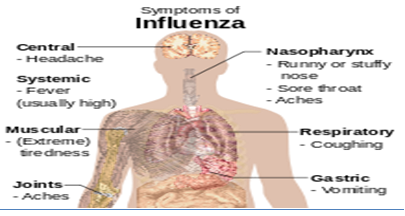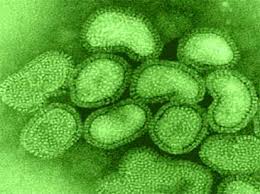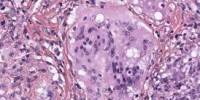Definition:
Viral flu is a viral infection. It’s passed on when people breathe in liquid droplets containing the influenza virus that have been sneezed or coughed into the air, or when people touch objects contaminated with the virus. The virus can cause infections all year round, but in the UK it’s most common in the winter. There are many strains, some of which are worse than others, such as swine flu (H1N1 strain).
Flu symptoms
Symptoms include fever, headache, cough, sore throat and muscle aches. They appear quickly, last for about seven days and generally leave you exhausted for weeks afterwards .
Duration
After 5 days, fever and other symptoms have usually disappeared, but a cough and etc weakness may continue. All symptoms are usually gone within a week or two.
Vairal Flu:
virus is a germ that is smaller than a bacteria. Viruses are encapsulated by a protective coating so they are more difficult to kill than bacteria. They are harder to treat because they are not susceptible to antibiotics like bacteria are because of their protective coating.
TYPES OF VIRUL FLU:
There are several types of flu. Such as:
- Common Cold
- Influenza,
- bird flu
- swine flu
Common Cold
The common cold (also called viral rhinitis) is a viral infection, characterized by nasal congestion, a clear, runny nose, sneezing, scratchy throat and general malaise.
Causes and Risk Factors of Common Cold
The set of symptoms we call a cold, may be caused by one of more than 100 different types of rhinovirus. The large number of different strains makes the chances of an effective vaccine slight. Rhinovirus grows well at relatively low temperatures, such as those found in the nose. This is why it’s rarely found in the trachea or lungs.
Symptoms of Common Cold
Headache, nasal congestion, a clear runny nose, sneezing, scratchy throat, and general malaise may all be symptoms of the common cold. A typical common cold will last three to four days; a mild secondary bacterial infection often prolongs this to a week or longer.
INFLUENZA:
Influenza, commonly referred to as the flu, is an infectious disease caused by RNA viruses of the family Orthomyxoviridae (the influenza viruses), that affects birds and mammals..
Although it is often confused with other influenza-like illnesses, especially the common cold, influenza is a more severe disease caused by a different type of virus. Influenza may produce nausea and vomiting, particularly in children,[1] but these symptoms are more common in the unrelated gastroenteritis.
Classification of influenza
In virus classification influenza viruses are RNA viruses that make up three of the five genera of the family Orthomyxoviridae:
- Influenza virus A
- Influenza virus B
- Influenza virus c
Influenza virus A:
This genus has one species, influenza A virus. Wild aquatic birds are the natural hosts for a large variety of influenza A. Occasionally; viruses are transmitted to other species and may then cause devastating outbreaks in domestic poultry or give rise to human influenza pandemics. The type A viruses are the most virulent human pathogens among the three influenza types and cause the most severe disease. The influenza A virus can be subdivided into different serotypes based on the antibody response to these viruses. The stereotypes that have been confirmed in humans, ordered by the number of known human pandemic deaths, in children, gastrointestinal symptoms such as diarrhea and abdominal pain, (may be severe in children.
Influenza virus B:
Influenza B almost exclusively infects humansand is less common than influenza A. The only other animals known to be susceptible to ferret. This type of influenza mutates at a rate 2–3 times slower than type A and consequently is less genetically diverse, with only one influenza B serotype. As a result of this lack of antigenic diversity, a degree of immunity to influenza B is usually acquired at an early age.
Influenza virus C:
This genus has one species, influenza C virus, which infects humans, dogs and pigs, sometimes causing both severe illness and local epidemics. However, influenza C is less common than the other types and usually only cause’s mild disease in children.
Symptoms of influenza:
The common sing &symptoms of influenza are:
- Aching muscles, especially in your back, arms and legs
- Chills and sweats
- Headache
- Dry cough
- Fatigue and weakness
- Nasal congestion
- fever (101 to 102 degrees),
- sneezing

Treatment of influenza:
Home Treatment
- Bed rest
- Drink extra fluids – at least one full glass of water or juice every hour.
- Acetaminophen (Tylenol), or Ibuprofen can relieve head and muscle aches. Aspirin should be avoided for children.
When to Call A Health Professional
- After three days of fever over 102 F.
- If cough brings up heavy mucus.
- If there is increasing difficulty in breathing.
- When a patient seemingly gets better, and then gets worse again.
- If flu-like symptoms occur 10 days to three weeks after a possible tick bite because of the possibility of Lyme’s disease
Stomach Flu
Gastroenteritis is inflammation of the stomach, intestines, or both. There are many causes of gastroenteritis; the most numerous cases are caused by viruses, followed by bacteria and other agents.
Norovirus: causes about 50% to 70% of all gastroenteritis or stomach flu in adults, the most common cause of gastroenteritis in the US, and second most common cause of death due to gastroenteritis.
Symptom of stomach flu:
The major symptoms of gastroenteritis are diarrhea, nausea, vomiting, and abdominal cramps; symptoms usually self-resolve in 2 to 5 days.
Stomach Flu Treatment
There is no medicine that will kill the viruses that cause stomach flu, treatment consists of managing symptoms while the body fights the infection. For people with stomach flu, treatment should begin with keeping the body hydrated. Other suggestions include getting plenty of rest, eating bland foods, and avoiding caffeine until the infection has passed.
Swine flu:
It is a contagious respiratory disease of pigs caused by type A influenza viruses. Swine flu (swine influenza) is a respiratory disease caused by that infects the respiratory tract of pigs and result in nasal secretions, a barking cough, decreased appetite, and listless behavior. Swine flu viruses may mutate (change) so that they are easily transmissible among animal and human.
Causes swine flu (H1N1)
The cause of swine flu is an influenza A virus type designated as H1N1. It has this designation or name because of the two major antigens (H and N) detectable on its surface by immunological techniques (H or hem agglutinin and N or neuraminidase).
Symptoms of swine flu:
The symptoms of swine influenza in people are similar to the symptoms of regular human seasonal influenza infection and include fever, fatigue, lack of appetite, coughing.
According to the CDC, like seasonal flu, symptoms of swine flu infections can include:
- fever, which is usually high, but unlike seasonal flu, is sometimes absent
- cough
- runny nose or stuffy nose
- sore throat
- body aches
- headache
- chills
- fatigue or tiredness, which can be extreme
- diarrhea and vomiting, sometimes, but more commonly seen than with seasonal flu
Serious Swine Flu Symptoms
As with other conditions, more serious symptoms that would indicate that a child with swine flu would need urgent medical attention include:
- Fast breathing or trouble breathing
- Bluish or gray skin color
- Not drinking enough fluids
- Severe or persistent vomiting
- Not waking up or not interacting
- Being so irritable that the child does not want to be held
- Flu-like symptoms improve but then return with fever and worse cough
Treatment of swine flu –
Swine flu is being treated with antiviral drugs such as Tamiflu and Relenza. Antiviral drugs work by preventing the flu virus from reproducing – to be effective you need to take them within 48 hours of the symptoms beginning. This can reduce the risk of complications and possibly shorten the illness by a day.
Antiviral medicine can cause side effects, such as:
- nausea
- vomiting
- diarrhea
- stomach ache
- headache
Even if you do feel these symptoms it is important that those prescribed antiviral medicine complete the course, even if symptoms of swine flu clear and you start to feel better quickly.
BIRD FLU:
Bird flu is an infection caused by avian (bird) influenza (flu) viruses (H5N1 virus). These flu viruses occur naturally among birds. Wild birds worldwide carry the viruses in their intestines, but usually do not get sick from them. However, bird flu is very contagious among birds and can make some domesticated birds, including chickens, ducks, and turkeys, very sick and kill the
Symptoms of bird flu:
Symptoms of avian flu infection in humans depend on the strain of virus. Infection with the H5N1 virus in humans causes typical flu-like symptoms, which might include:
- Cough (dry or productive)
- Diarrhea
- Difficulty breathing
- Fever greater than 100.4°F (38°C)
- Headache
- Malaise
- Muscle aches
- Runny nose
- Sore throat
Treatment of bird flu:
Bird flu, or avian flu, is currently of great concern worldwide. Governments are greatly concerned of a pandemic of bird flu that could kill millions.Tamiflu is the main drug for the treatment of bird flu. Tamiflu can lessen the effects of bird flu, speed up recovery. Tamiflu can also minimize the effects of bird flu to the point that a patient may survive the virus when, without Tamiflu, the attack would have been fatal. Tamiflu is the only drug that is this effective against the bird flu virus.
References
- “Influenza: Viral Infections: Merck Manual Home Edition”. Merck. Retrieved 15 March 2008.
- Eccles, R (2005). “Understanding the symptoms of the common cold and influenza”. Lancet Infect Dis 5 (11): 718–25. DOI:10.1016/S1473-3099(05)70270-X. PMID 16253889.
- ^ Seasonal Flu vs. Stomach Flu by Kristina Duda, R.N.; Retrieved 12 March 2007 (Website: “About, Inc., A part of The New York Times Company”). So-called “stomach flu” is sometimes also called “24-hour flu.” Neither one is actually flu and is instead unrelated gastroenteritis.
- Time Lines of Infection and Disease in Human Influenza: A Review of Volunteer Challenge Studies, American Journal of Epidemiology, Carat, Vergu, Ferguson, et al., 167 (7): 775-785, 2008. “ . . . In almost all studies, participants were individually confined for 1 week. . . ” See especially Figure 5 which shows that virus shedding tends to peak on day 2 whereas symptoms tend to peak on day 3.
- ^ Ballinger, MN; Stand ford, TJ (Sep 2010). “Post influenza bacterial pneumonia: host defenses gone awry”. J Interferon Cytokine Res 30 (9): 643–52. DOI:10.1089/jir.2010.0049. PMID 20726789.
- ^ a b c d Hospitalized Patients with 2009 H1N1 Influenza in the United States, April–June 2009, New England Journal of Medicine, Jain, Kamimoto, et al., 12 Nov. 2009.
- Transcript of virtual press conference with Gregory Harts, Spokesperson for H1N1, and Dr Nikki Shin do, Medical Officer, Global Influenza Programmed, World Health Organization, 12 November 2009.
.

















